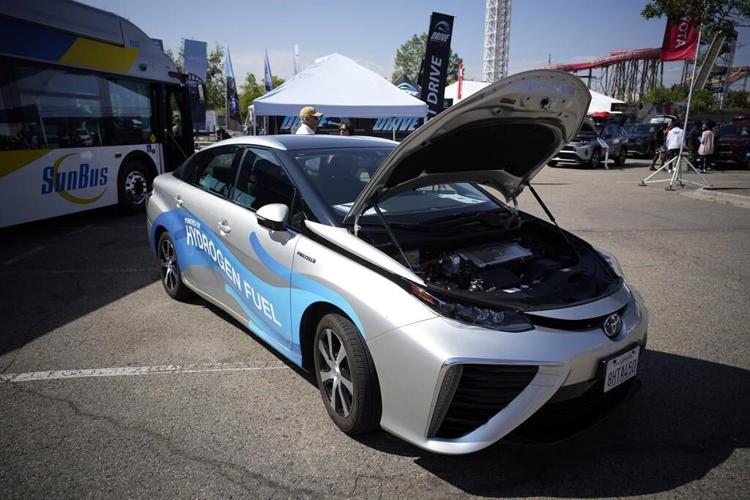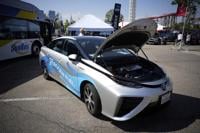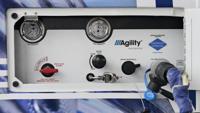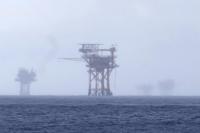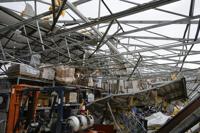WASHINGTON (AP) — The Biden administration has selected clean-energy projects from Pennsylvania to California for a $7 billion program to kickstart development and production of hydrogen fuel, a key component of President Joe Biden's agenda to slow climate change.
Biden called clean hydrogen essential to his vision of net-zero greenhouse gas emissions in the U.S. by 2050. His goal is to establish seven regional hubs to help replace fossil fuels such as coal and oil with cleaner-burning hydrogen as an energy source for vehicles, manufacturing and generating electricity.
The seven hubs, which include projects in 16 states, will spur more than $40 billion in private investment and create tens of thousands of good-paying jobs, many of them union positions, Biden said Friday at a cargo terminal in Philadelphia, where one of the hubs will be based.
He called the announcement transformational and said it would help create “a stronger, energy-secure economy'' and combat “the existential threat of climate change.''
“It’s all part of my plan to make things in America,” he said.
The projects selected are based in California, Washington, Minnesota, Texas, Pennsylvania, West Virginia and Illinois. All but the California and Texas hubs include projects in multiple states. Pennsylvania has projects in two separate hubs.
Biden signed in 2021 included billions of dollars to develop so-called clean hydrogen, a technology that industry and clean-energy advocates have long pushed as a way to reduce planet-warming greenhouse gas emissions produced by fossil fuels.
Some environmentalists call hydrogen a false solution because it frequently relies on natural gas as a fuel source.
Energy companies say fossil fuels can by used if the projects capture the carbon dioxide produced and keep it out of the atmosphere, a technology that has yet to be produced at commercial scale.
States and businesses have been competing for federal dollars in , which will create regional networks of hydrogen producers, consumers and infrastructure. The intent is to accelerate the availability and use of the colorless, odorless gas that already powers some vehicles and trains.
Among those selected were the Appalachian Regional Clean Hydrogen Hub, based in West Virginia, and the Philadelphia-based Mid-Atlantic Clean Hydrogen Hub. Pennsylvania, a battleground state of the highest importance to the Democratic president in next year’s election, is in line to benefit from both projects.
Biden has made Philadelphia a regular stop for both official and campaign events, and partners in the proposed Philadelphia-area hub have labor unions that are key Biden supporters. The West Virginia-based hub includes major Pittsburgh-based natural gas companies that are active in the region’s prolific Marcellus Shale reservoir, including natural gas producer EQT Corp., which expects its gas to flow through the controversial Mountain Valley Pipeline in West Virginia and Virginia.
Sen. Joe Manchin, a West Virginia Democrat who muscled in an unusual agreement with the White House this year, hailed the Appalachian hub.
“This means West Virginia will be the new epicenter of hydrogen in the United States of America,” he said of the hub, which will receive up to $925 million in federal spending. “West Virginia will be on the leading edge of building out the new hydrogen market.''
The Appalachian hub will extend to Ohio and includes a $1.6 billion facility under construction in northern Pennsylvania that is working to produce near-zero emissions hydrogen from natural gas.
“This is a big, big deal for ... Appalachia in particular, because these facilities are all based in areas where coal was king,'' said Perry Babb, president of KeyState, an owner and developer of the Pennsylvania site.
The Mid-Atlantic hub, which includes New Jersey and Delaware, will receive $750 million and will make hydrogen through electrolysis — splitting water molecules using renewable energy sources such as wind and solar power, as well as nuclear power.
The two largest projects are in California and Texas; each will receive up to $1.2 billon.
The Alliance for Renewable Clean Hydrogen Energy Systems in California will produce hydrogen from renewable energy and biomass. The project is intended to provide a blueprint for decarbonizing public transportation, heavy-duty trucking and port operations — key emissions drivers in the state and major sources of air pollution.
In order to achieve ambitious climate goals, “we have to address these intensive industries,” including ports, aviation, shipping and agriculture, as well as large power plants and cement and steel plants, California Gov. Gavin Newsom said Friday.
The Gulf Coast Hydrogen Hub will be centered in Houston, long the energy capital of the U.S., and plans large-scale hydrogen production from both natural gas and renewables. “This historic investment will further cement Texas’ position as the national leader in energy and hydrogen production,'' said Texas Gov. Greg Abbott.
The Minnesota-based Heartland hub, which includes projects in North and South Dakota, will receive $925 million as it seeks to decarbonize fertilizer used in agriculture and advance use of clean hydrogen in electric generation and for cold climate space heating. It also plans to offer equity ownership to tribal communities and local farmers.
The Midwest hub in Illinois, Indiana and Michigan will receive up to $1 billion and will use hydrogen in steel and glass production, power generation, heavy-duty transportation and sustainable aviation fuel. The hub plans to use renewable energy, natural gas and nuclear energy.
The Pacific Northwest hub, based in eastern Washington, will extend to Oregon and Montana and will use hydropower and other renewable resources to produce clean hydrogen.
Sen. Patty Murray, D-Wash., called the $1 billion hub “great news for the Pacific Northwest," adding that it will create thousands of jobs and "make sure that Washington plays a leading role in growing the green hydrogen economy.''
Nearly every state had joined at least one proposed hub, and many have been working together, hoping to reap the economic development and thousands of jobs they would bring. Big fossil fuel companies, renewable energy developers and researchers in university and government labs are involved, too.
Environmental groups are skeptical, arguing that while hydrogen is a clean-burning source of power, it takes a great deal of energy to produce. When it’s made with electricity from coal or natural gas, it has a bigger carbon footprint than simply burning the source fuel.
“We need strong guardrails to ensure that U.S. hydrogen does not create an emissions mess, and that we are not subsidizing hydrogen that is clean in name only,” said Erik Kamrath, federal hydrogen advocate at Natural Resources Defense Council, an environmental group.
Anna Menke, senior hydrogen hubs manager at Clean Air Task Force, another environmental group, called the new hubs “a critical first step'' to reduce emissions from carbon-intensive industries such as ammonia used for fertilizers and petrochemicals used in refining. New uses of hydrogen in sectors such as heavy-duty trucking, shipping and aviation are potential game changers, she said, adding: “We must ensure the program delivers on these promises.''
___
Associated Press writers Marc Levy in Harrisburg, Pennsylvania, and Julie Watson in San Diego contributed to this story.

